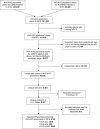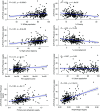Supply and Distribution of Vascular Access Physicians in the United States: A Cross-Sectional Study
- PMID: 34355198
- PMCID: PMC8336638
- DOI: 10.34067/kid.0002722020
Supply and Distribution of Vascular Access Physicians in the United States: A Cross-Sectional Study
Abstract
Background: Because functioning permanent vascular access (arteriovenous fistula [AVF] or arteriovenous graft [AVG]) is crucial for optimizing patient outcomes for those on hemodialysis, the supply of physicians placing vascular access is key. We investigated whether area-level demographic and healthcare market attributes were associated with the distribution and supply of AVF/AVG access physicians in the United States.
Methods: A nationwide registry of physicians placing AVFs/AVGs in 2015 was created using data from the United States Renal Data System and the American Physician Association's Physician Masterfile. We linked the registry information to the Area Health Resource File to assess the supply of AVF/AVG access physicians and their professional attributes by hospital referral region (HRR). Bivariate analysis and Poisson regression were performed to examine the relationship between AVF/AVG access physician supply and demographic, socioeconomic, and health resource conditions of HRRs. The setting included all 50 states. The main outcome was supply of AVF/AVG access physicians, defined as the number of physicians performing AVF and/or AVG placement per 1000 prevalent patients with ESKD.
Results: The majority of vascular access physicians were aged 45-64 (average age, 51.6), male (91%), trained in the United States (76%), and registered in a surgical specialty (74%). The supply of physicians varied substantially across HRRs. The supply was higher in HRRs with a higher percentage white population (β=0.44; SEM=0.14; P=0.002), lower unemployment rates (β=-10.74; SEM=3.41; P=0.002), and greater supply of primary care physicians (β=0.18; SEM=0.05; P=0.001) and nephrologists (β=15.89; SEM=1.22; P<0.001).
Conclusions: Geographic variation was observed in the supply of vascular access physicians. Higher supply of such specialist physicians in socially and economically advantaged areas may explain disparities in vascular access and outcomes in the United States and should be the subject of further study and improvement.
Conflict of interest statement
All authors have nothing to disclose.
Figures




Similar articles
-
Assessment of Use of Arteriovenous Graft vs Arteriovenous Fistula for First-time Permanent Hemodialysis Access.JAMA Surg. 2019 Sep 1;154(9):844-851. doi: 10.1001/jamasurg.2019.1736. JAMA Surg. 2019. PMID: 31188411 Free PMC article.
-
International Differences in the Location and Use of Arteriovenous Accesses Created for Hemodialysis: Results From the Dialysis Outcomes and Practice Patterns Study (DOPPS).Am J Kidney Dis. 2018 Apr;71(4):469-478. doi: 10.1053/j.ajkd.2017.09.012. Epub 2017 Dec 1. Am J Kidney Dis. 2018. PMID: 29198387
-
Costs Attributable to Arteriovenous Fistula and Arteriovenous Graft Placements in Hemodialysis Patients with Medicare coverage.Am J Nephrol. 2019;50(4):320-328. doi: 10.1159/000502507. Epub 2019 Aug 21. Am J Nephrol. 2019. PMID: 31434095
-
Gender differences in vascular access in hemodialysis patients in the United States: developing strategies for improving access outcome.Gend Med. 2007 Sep;4(3):193-204. doi: 10.1016/s1550-8579(07)80040-4. Gend Med. 2007. PMID: 18022587 Review.
-
Establishing patient-specific criteria for selecting the optimal upper extremity vascular access procedure.J Vasc Surg. 2017 Apr;65(4):1089-1103.e1. doi: 10.1016/j.jvs.2016.10.099. Epub 2017 Feb 17. J Vasc Surg. 2017. PMID: 28222990 Free PMC article. Review.
Cited by
-
Kidney Disease Education Services: A Good Foundation, but More Is Needed!Kidney360. 2022 Jan 27;3(1):3-4. doi: 10.34067/KID.0007632021. eCollection 2022 Jan 27. Kidney360. 2022. PMID: 35368568 Free PMC article. No abstract available.
-
Socioeconomic Status and Vascular Access Patency in Hemodialysis: Analysis of Korean National Health Insurance Service Data from 2008 to 2019.J Clin Med. 2025 Apr 29;14(9):3074. doi: 10.3390/jcm14093074. J Clin Med. 2025. PMID: 40364105 Free PMC article.
-
Impact of neighborhood social disadvantage on the presentation and management of peripheral artery disease.J Vasc Surg. 2023 May;77(5):1477-1485. doi: 10.1016/j.jvs.2022.12.062. Epub 2023 Jan 7. J Vasc Surg. 2023. PMID: 36626955 Free PMC article.
-
Racial Disparities in Arteriovenous Fistula Use Among Hemodialysis Patients: The Role of Surgeon Supply.Kidney Int Rep. 2022 Apr 12;7(7):1575-1584. doi: 10.1016/j.ekir.2022.04.010. eCollection 2022 Jul. Kidney Int Rep. 2022. PMID: 35812267 Free PMC article.
-
New Frontiers in Vascular Access Practice: From Standardized to Patient-tailored Care and Shared Decision Making.Kidney360. 2021 Jun 15;2(8):1380-1389. doi: 10.34067/KID.0002882021. eCollection 2021 Aug 26. Kidney360. 2021. PMID: 35369664 Free PMC article. Review.
References
-
- Nassar GM, Ayus JC: Infectious complications of the hemodialysis access. Kidney Int 60: 1–13, 2001 - PubMed
-
- Fokou M, Teyang A, Ashuntantang G, Kaze F, Eyenga VC, Chichom Mefire A, Angwafo F 3rd: Complications of arteriovenous fistula for hemodialysis: An 8-year study. Ann Vasc Surg 26: 680–684, 2012 - PubMed
-
- Thamer M, Lee TC, Wasse H, Glickman MH, Qian J, Gottlieb D, Toner S, Pflederer TA: Medicare costs associated with arteriovenous fistulas among US hemodialysis patients. Am J Kidney Dis 72: 10–18, 2018 - PubMed
-
- Tokars JI, Light P, Anderson J, Miller ER, Parrish J, Armistead N, Jarvis WR, Gehr T: A prospective study of vascular access infections at seven outpatient hemodialysis centers. Am J Kidney Dis 37: 1232–1240, 2001 - PubMed
-
- Dhingra RK, Young EW, Hulbert-Shearon TE, Leavey SF, Port FK: Type of vascular access and mortality in U.S. hemodialysis patients. Kidney Int 60: 1443–1451, 2001 - PubMed
Publication types
MeSH terms
Grants and funding
LinkOut - more resources
Full Text Sources
Medical

